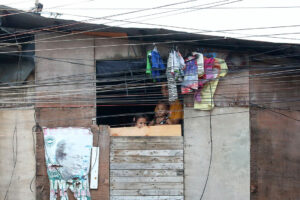




Philippines Trade Update: Trade trajectories trend along
 DOWNLOAD
DOWNLOAD

Policy Rate Updates: Double cut finale
 DOWNLOAD
DOWNLOAD

Monthly Economic Update: One for the road
 DOWNLOAD
DOWNLOAD


Poverty falls to below pre-pandemic level in 2023

About 17.54 million Filipinos were living in poverty in 2023, significantly lower than the nearly 20 million in 2021, the Philippine Statistics Authority (PSA) reported on Monday.
Based on preliminary results of the PSA’s Family Income and Expenditure Survey (FIES), the poverty incidence among the population fell to 15.5% from the 18.1% estimate in 2021.
“This present figure is even lower than the pre-pandemic level of 16.7% in 2018,” President Ferdinand R. Marcos, Jr. said in his State of the Nation Address on Monday. He added that almost 2.5 million Filipinos were lifted from poverty.
The latest figure is also lower than the government’s development target for poverty incidence in 2023 at 16-16.4% under the Philippine Development Plan (PDP) 2023-2028.
Meanwhile, the poverty incidence among families was recorded at 10.9%, or about three million poor families.
The PSA defines poverty incidence as the proportion of Filipino families with incomes that are not sufficient to buy their minimum basic food and nonfood needs as estimated by the poverty threshold.
Meanwhile, 2.7% of Filipino families or about 740,000 families did not have enough income to meet their basic food needs.
Among the population, 4.3% or about 4.84 million Filipinos were living below the food poverty threshold.
With these results, the poverty situation in the Philippines has returned to its pre-pandemic levels, the PSA said.
National Economic and Development Authority Secretary Arsenio M. Balisacan said the lower poverty incidence reflects government efforts to implement effective policies and initiatives to improve the lives of Filipinos.
“High inflation during the first half of 2023 likely partially offset the positive effects of income growth on poverty reduction. The decline in poverty could have been sharper had inflation been more moderate,” Mr. Balisacan said in a statement.
He said economic growth was progressive, given that the average income per person for the poorest Filipinos grew more quickly than those in the top decile class and faster than the rate at which the poverty threshold increased.
Mr. Balisacan also said food security remains a top government priority, and creating more high-quality jobs and developing human capital to improve the earning potential of Filipinos are areas to focus on.
The local statistics agency added that the decline in poverty from 2021 was due to the poverty threshold and income data from 2021 to 2023.
Preliminary data showed that the poverty threshold, which is mainly influenced by changes in food prices, grew by 15.3% from 11.8% previously (2018-2021).
Meanwhile, 2023 FIES data also showed that the mean per capita income, particularly for families near the poverty threshold, jumped by 22.9% from 9.2%, higher than the increase in the poverty threshold.
Security Bank Corp. Chief Economist Robert Dan J. Roces said poverty reduction likely stemmed from a combination of some economic growth, job creation, government aid programs, and stable but high inflation, particularly among food.
“While this is positive, the unbanked population may not have fully benefited yet. Increased per capita income, possibly due to economic growth or rising wages, is encouraging,” Mr. Roces said in a Viber message.
Jesus Felipe, a professor of economics at De La Salle University, said the poverty incidence would continue to decline in the coming years but not as fast as hoped.
“Since poverty in the Philippines is mostly a rural phenomenon, the decline in poverty is linked to improvements in agriculture, in particular to the decline in the share of employment in this sector,” he said in an e-mail.
Headline inflation in 2023 averaged 6%, slightly higher than 5.8% in 2022. Meanwhile, the jobless rate hit an all-time low of 4.3% last year, the lowest in two decades, according to the local statistics agency. — Abigail Marie P. Yraola
In 2023, the agriculture sector grew by 1.2% from 0.5% in 2022 and the 0.3% contraction in 2021. Meanwhile, the Philippine economy grew by 5.5% in 2023 from 7.6% in 2022 and 5.7% in 2021.
“We forecast that the poverty incidence will decline to 14% in 2026, 13.3% in 2028 and 12.2% in 2030,” Mr. Felipe said. — Abigail Marie P. Yraola
This article originally appeared on bworldonline.com





 By BusinessWorld
By BusinessWorld